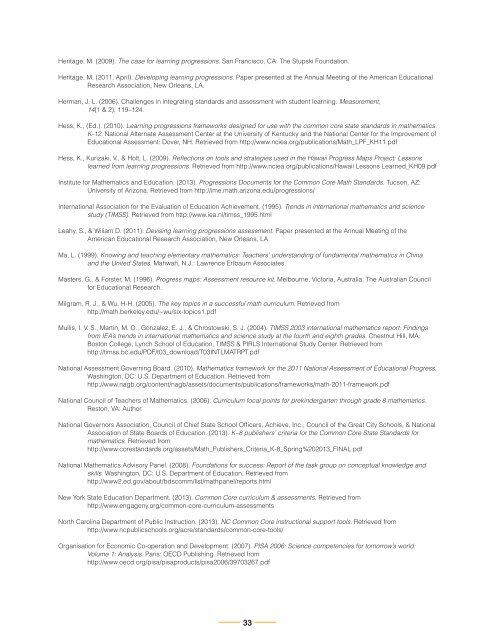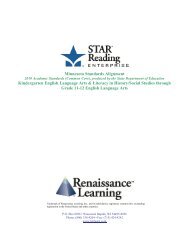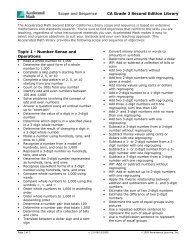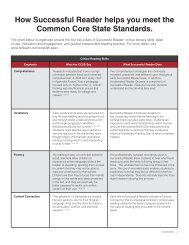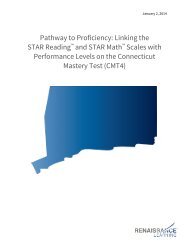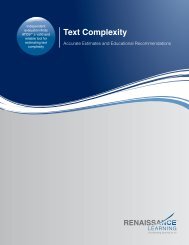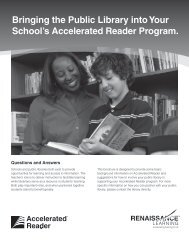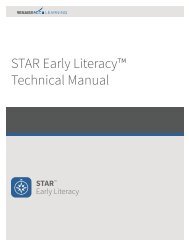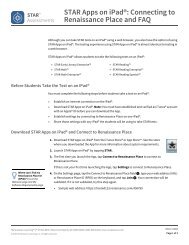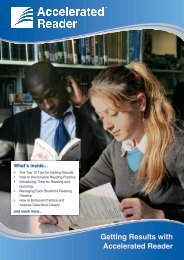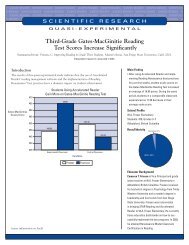Core Progress⢠for Math - Renaissance Learning
Core Progress⢠for Math - Renaissance Learning
Core Progress⢠for Math - Renaissance Learning
You also want an ePaper? Increase the reach of your titles
YUMPU automatically turns print PDFs into web optimized ePapers that Google loves.
Heritage, M. (2009). The case <strong>for</strong> learning progressions. San Francisco, CA: The Stupski Foundation.Heritage, M. (2011, April). Developing learning progressions. Paper presented at the Annual Meeting of the American EducationalResearch Association, New Orleans, LA.Herman, J. L. (2006). Challenges in integrating standards and assessment with student learning. Measurement,14(1 & 2), 119–124.Hess, K., (Ed.). (2010). <strong>Learning</strong> progressions frameworks designed <strong>for</strong> use with the common core state standards in mathematicsK-12. National Alternate Assessment Center at the University of Kentucky and the National Center <strong>for</strong> the Improvement ofEducational Assessment: Dover, NH. Retrieved from http://www.nciea.org/publications/<strong>Math</strong>_LPF_KH11.pdfHess, K., Kurizaki, V., & Holt, L. (2009). Reflections on tools and strategies used in the Hawaii Progress Maps Project: Lessonslearned from learning progressions. Retrieved from http://www.nciea.org/publications/Hawaii Lessons Learned_KH09.pdfInstitute <strong>for</strong> <strong>Math</strong>ematics and Education. (2013). Progressions Documents <strong>for</strong> the Common <strong>Core</strong> <strong>Math</strong> Standards. Tucson, AZ:University of Arizona. Retrieved from http://ime.math.arizona.edu/progressions/International Association <strong>for</strong> the Evaluation of Education Achievement. (1995). Trends in international mathematics and sciencestudy (TIMSS). Retrieved from http://www.iea.nl/timss_1995.htmlLeahy, S., & Wiliam D. (2011). Devising learning progressions assessment. Paper presented at the Annual Meeting of theAmerican Educational Research Association, New Orleans, LA.Ma, L. (1999). Knowing and teaching elementary mathematics: Teachers’ understanding of fundamental mathematics in Chinaand the United States. Mahwah, N.J.: Lawrence Erlbaum Associates.Masters, G., & Forster, M. (1996). Progress maps: Assessment resource kit. Melbourne, Victoria, Australia: The Australian Council<strong>for</strong> Educational Research.Milgram, R. J., & Wu, H-H. (2005). The key topics in a successful math curriculum. Retrieved fromhttp://math.berkeley.edu/~wu/six-topics1.pdfMullis, I. V. S., Martin, M. O., Gonzalez, E. J., & Chrostowski, S. J. (2004). TIMSS 2003 international mathematics report: Findingsfrom IEA’s trends in international mathematics and science study at the fourth and eighth grades. Chestnut Hill, MA:Boston College, Lynch School of Education, TIMSS & PIRLS International Study Center. Retrieved fromhttp://timss.bc.edu/PDF/t03_download/T03INTLMATRPT.pdfNational Assessment Governing Board. (2010). <strong>Math</strong>ematics framework <strong>for</strong> the 2011 National Assessment of Educational Progress.Washington, DC: U.S. Department of Education. Retrieved fromhttp://www.nagb.org/content/nagb/assets/documents/publications/frameworks/math-2011-framework.pdfNational Council of Teachers of <strong>Math</strong>ematics. (2006). Curriculum focal points <strong>for</strong> prekindergarten through grade 8 mathematics.Reston, VA: Author.National Governors Association, Council of Chief State School Officers, Achieve, Inc., Council of the Great City Schools, & NationalAssociation of State Boards of Education. (2013). K–8 publishers’ criteria <strong>for</strong> the Common <strong>Core</strong> State Standards <strong>for</strong>mathematics. Retrieved fromhttp://www.corestandards.org/assets/<strong>Math</strong>_Publishers_Criteria_K-8_Spring%202013_FINAL.pdfNational <strong>Math</strong>ematics Advisory Panel. (2008). Foundations <strong>for</strong> success: Report of the task group on conceptual knowledge andskills. Washington, DC: U.S. Department of Education. Retrieved fromhttp://www2.ed.gov/about/bdscomm/list/mathpanel/reports.htmlNew York State Education Department. (2013). Common <strong>Core</strong> curriculum & assessments. Retrieved fromhttp://www.engageny.org/common-core-curriculum-assessmentsNorth Carolina Department of Public Instruction. (2013). NC Common <strong>Core</strong> instructional support tools. Retrieved fromhttp://www.ncpublicschools.org/acre/standards/common-core-tools/Organisation <strong>for</strong> Economic Co-operation and Development. (2007). PISA 2006: Science competencies <strong>for</strong> tomorrow’s world:Volume 1: Analysis. Paris: OECD Publishing. Retrieved fromhttp://www.oecd.org/pisa/pisaproducts/pisa2006/39703267.pdf33


